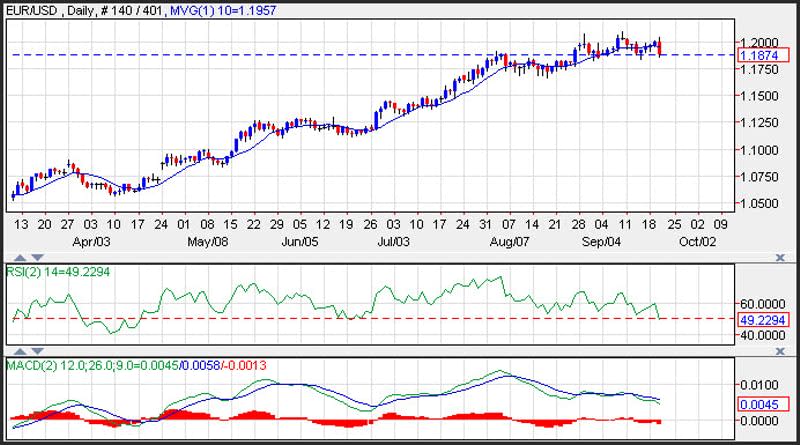EUR/USD Daily Technical Analysis for September 21, 2017
The EUR/USD moved lower on Wednesday following the Federal Research report where the central bank left interest rates unchanged. The Fed announced that they would move forward with quantitative tightening which would amount to approximately 600 billion in reduction in the balance sheet each year moving forward. The FOMC signaled that another rate hike is still likely if appropriate in December. Of the 16 Fed members who are voting, 11-think that one or more hike this year is likely. The dot plots, which show the each Fed members forward forecast suggest that it will take a year longer to reach the Fed funds level that is a neutral rate. The Fed signaled a more gradual approach moving forward with only 3-rate hikes in 2019 and 2020. Furthermore, the Fed cut the long-term rate from 3.0% to 2.75%.
Technicals
The EUR/USD moved lower as the dollar gained traction and yields moved higher. Support is seen near last week’s lows at 1.1834. Resistance is seen near last week’s highs at 1.2092. The relative strength index (RSI) which is a momentum oscillator that measures accelerating and decelerating momentum, broke through support, reflecting accelerating negative momentum. The MACD (moving average convergence divergence) histogram is printing in the red with a downward sloping trajectory which points to a lower exchange rate.

The Fed Was More Hawkish than Expected
The Fed’s assessment of the economy did not change much. The Fed also accepted that the recent hurricanes will cause near-term disturbances but the underlying trajectory of the economy was not likely to be altered. By still anticipating another hike this year, the underlying signal from the Fed was somewhat more hawkish that the market expected.
German Producer Prices Were Stronger than Expected
German producer price inflation higher than expected. The annual rate rose to 2.6% year over year in August, from 2.2% year over year in the previous month. A renewed uptick in energy prices was the main factor and energy prices rose 0.4% month over month, fuel prices 0.9% month over month and annual rates rose to 2.7 %year over year and 3.9% year over year respectively. Annual food price inflation fell back slightly, but at 5.3% year over year remains very higher and PPI excluding energy rose to 2.6% year over year from 2.5% year over year. Overall PPI remains below the highs seen earlier in the year, but seems to have bottomed out and the data will back the arguments of the hawks at the ECB, who are fighting for the end of additional asset purchases.
European Institute Sees Steady Growth
European institutes see steady growth ahead. The joint forecast by Ifo, which is in Germany, Istat, in Italy and the KOF, in Switzerland for the Eurozone going ahead project growth of 0.6% quarter over quarter in Q3 and Q4 this year, followed by a marginal slowdown in the quarterly growth rate to 0.5% in the first quarter of 2018. Annual growth rates are seen steady at 2.4% throughout the forecast period. Inflation is expected to average 1.5%, but fall back to 1.1% in Q1 next year, which will give the doves at the ECB something to argue with.
UK August Retail Sales Beat Expectations
UK August retail sales beat expectations, rising 1.0% month over month and by 2.8% on the year-on-year comparison. The respective median forecasts had been for much more modest growth rates of 0.2% month over month and 1.3% year over year. July data were also revised higher, to 0.7% month over month, from 0.5%, and to 1.7% year over year, from 1.5% year over year. Good news as the consumer sector is the dominant driver in the UK economy, and with BoE having said that it is keeping a close eye on how households respond to developments related to the process of withdrawing from the EU.
Despite a robust retail sales report, the BoE agents report is a survey of anecdotal activity across the economy, comparing activity and prices from a year earlier. Today’s release covers the period from May to August of this year, and found that demand growth in several consumer-facing sectors had slowed, and that investment intentions had weakened with the dominant services sector, though were more position for goods exporters. It also noted that while growth in labor costs had been subdued, recruitment difficulties remained elevated, with conditions becoming “very tight” for some skills, which is something that the BoE’s hawkish-leaning statement of last week highlighted.
The U.S. MBA Mortgage Market Dropped
U.S. MBA mortgage market index sank 9.7% in data released earlier, accompanied by a 10.8% drop in purchases and a 8.5% decline in refinancing activity for the week ended September 15. The 30-year fixed mortgage rate rose only 1 basis point to 4.04%, though yields snapped back last week after the hurricanes and heading towards today’s FOMC storm. Like others, the housing sector will be distorted somewhat by regional swings in the significant Texas and Florida regions, which will make a clean read on the housing sector challenging in the months ahead.
This article was originally posted on FX Empire

 Yahoo Finance
Yahoo Finance 